Research on Improvement of Data Synchronization Method for Distribution Network Differential Protection Based on 5G
Abstract
1. Introduction
2. The Combination of Differential Protection and 5G
2.1. Differential Protection under 5G Communication
2.2. Synchronization Method for 5G Timing
3. Consider Improving Time Synchronization by Combining Satellites with 5G Networks
3.1. Combination of Satellite and 5G
3.2. Delay Analysis before and after Synchronous Improvement
4. Simulation Verification
5. Conclusions
Author Contributions
Funding
Data Availability Statement
Acknowledgments
Conflicts of Interest
References
- Serizawa, Y.; Kitamura, K.; Myoujin, M.; Shimizu, K.; Matsushima, T.; Morimitsu, M. SDH-based time synchronous system for power system communications. IEEE Trans. Power Deliv. 1998, 13, 59–65. [Google Scholar] [CrossRef]
- Wei, Q. 4G LTE Wireless Communication Technology and Its Applications in Power Private Networks. Master’s Thesis, Nanjing University of Posts and Telecommunications, Nanjing, China, 2018. [Google Scholar]
- Zhao, H.; Chen, C.; Wang, Z.; Wang, H. Evolution strategy from 4G wireless private network to 5G in power CPS environment. Electr. Power 2021, 54, 68–79. [Google Scholar]
- Bag, G.; Thrybom, L.; Hovila, P. Challenges and opportunities of 5G in power grids. CIRED-Open Access Proc. J. 2017, 2017, 2145–2148. [Google Scholar] [CrossRef]
- Wang, C.; Zheng, L.; Zhao, Z.; Lv, Z.; Jiang, X.; Liu, H.; Yuan, C. Research on Communication Solutions Under the Background of New Power System. In Proceedings of the 2023 International Conference on Power System Technology (PowerCon), Jinan, China, 21–22 September 2023; pp. 1–6. [Google Scholar]
- Chen, G.; Wei, H.; Zhang, Y.; Guo, C.; Shi, S.; Wang, Z.; Yan, T.; Ma, S. Application of 5G Communication Technology in Power Communication and Research on Key Technologies. IOP Conf. Ser. Earth Environ. Sci. 2021, 791, 012151. [Google Scholar] [CrossRef]
- Zhao, A.; Huang, Y.; Song, G.; Zhu, Y.; Zhang, J. Configuration strategy and application of distribution network protection based on standalone 5G. Power Syst. Prot. Control 2021, 49, 24–31. [Google Scholar]
- Zhou, X.; Li, Z.; Liu, X.; Zhou, Z. Latest Research Progress and Practice of 5G Slicing Technology in China’s New Power System. In Proceedings of the 2023 8th Asia Conference on Power and Electrical Engineering (ACPEE), Tianjin, China, 14–16 April 2023; pp. 1509–1516. [Google Scholar]
- Weiliang, G.; Houlei, G.; Bin, X.; Lin, L. Feasibility analysis of adopting 5G in differential protection of distribution networks. Power Syst. Prot. Control 2021, 49, 1–7. [Google Scholar]
- Yuan, T.; Gao, H.L.; Xu, B.; Li, X. Research on 5G high-precision time synchronization and its application mode in power grid. Electric Power ICT 2020, 18, 47–53. [Google Scholar]
- Minjiang, X.; Tong, Y.; Shancheng, S.; Bao, L.; Wenwei, S.; Houlei, G. 5G timing base data synchronization scheme for differential protection of distribution networks. Power Syst. Prot. Control 2021, 49, 8–15. [Google Scholar]
- Chen, C.; Huo, Y.; Yue, F.; Zhang, Y. Research and application of data synchronization method for differential protection of distribution network based on 5G communication. Zhejiang Electr. Power 2021, 40, 68–72. [Google Scholar]
- Zou, X.; Shen, B.; Jiang, X. A quick action scheme of differential protection for a distribution network with 5G communication. Power Syst. Prot. Control 2022, 50, 163–169. [Google Scholar]
- Pu, H.; Wu, T.; Yao, G.; Hong, F.; Zheng, X.; Wang, W.; Li, X. A New Differential Protection Scheme of Distribution Network Line Based on Improved DTW Algorithm and 5G Communication. In The Purple Mountain Forum on Smart Grid Protection and Control; Springer Nature: Singapore, 2019; pp. 183–200. [Google Scholar]
- Hao, H.; Wang, T.; Zhu, S.; Hou, Z.; Huang, Y. Differential protection of distribution network based on 5G and particle swarm algorithms. Electr. Meas. Instrum. 2023, 1–9. Available online: https://kns-cnki-net.webvpn.xju.edu.cn:8040/kcms/detail/23.1202.TH.20230215.0959.002.html (accessed on 1 January 2024).
- Huang, Y.; Zhu, Y.; He, M.; Song, G.; Cheng, J. Time synchronization algorithm of distribution network line differential protection based on 5G. Distrib. Util. 2022, 39, 11–16+44. [Google Scholar]
- Wang, D.; Yuan, Z.; Wang, W.; Zhi, K. Pilot Protection of a Distribution Network with Distributed Generators Based on 5G and Dynamic Time Warping Considering Cosine Transform. Energies 2023, 16, 7762. [Google Scholar] [CrossRef]
- Hui, L.; QiBo, S. Service Migration in Mobile Edge Computing Based on 5G Network User Plane. In International Conference on Big Data Intelligence and Computing; Springer Nature: Singapore, 2022; pp. 535–546. [Google Scholar]
- Mahmood, A.; Ashraf, M.I.; Gidlund, M.; Torsner, J.; Sachs, J. Time synchronization in 5G wireless edge: Requirements and solutions for critical-MTC. IEEE Commun. Mag. 2019, 57, 45–51. [Google Scholar] [CrossRef]
- Xu, H.; Xin, J.; Xu, S.; Zhang, H. RAN enhancement to support propagation delay compensation of TSN. In Proceedings of the 2021 IEEE 9th International Conference on Information, Communication and Networks (ICICN), Xi’an, China, 25–28 November 2021; pp. 179–182. [Google Scholar]
- Satka, Z.; Ashjaei, M.; Fotouhi, H.; Daneshtalab, M.; Sjödin, M.; Mubeen, S. A comprehensive systematic review of integration of time sensitive networking and 5G communication. J. Syst. Archit. 2023, 138, 102852. [Google Scholar] [CrossRef]
- Cai, Y.; Zhang, X.; Hu, S.; Wei, X. Dynamic QoS mapping and adaptive semi-persistent scheduling in 5G-TSN integrated networks. China Commun. 2023, 20, 340–355. [Google Scholar] [CrossRef]
- Wijethilaka, S.; Liyanage, M. Survey on network slicing for Internet of Things realization in 5G networks. IEEE Commun. Surv. Tutor. 2021, 23, 957–994. [Google Scholar] [CrossRef]
- Li, W.; Sun, L.; Wang, J.Q.; Ma, Z.C. Key technologies to enable 5G and TSN coordination for industrial automation. J. Eng. Sci. 2022, 44, 1044–1052. [Google Scholar]
- Zhang, M.; Xie, J.; Wu, Z.; Fu, Y.; Shi, R.; Guo, H. Design of High-precision Time Display System Based on GPS and BeiDou Satellite Timing. Electron. Prod. 2021, 66–67+75. [Google Scholar] [CrossRef]
- Xu, R.; Zhao, J.; Tian, X.; Dai, W. Scheme of beidou high-precision time synchronization technology. J. Navig. Position. 2023, 11, 154–158. [Google Scholar]
- Wang, C.; Zhao, Y. Analysis of delay jitter in power differential protection service based on 5G carrier network. Commun. World 2019, 33–36. [Google Scholar] [CrossRef]
- Zhang, J.Y.; Jiang, R.Z.; Li, J.G. Research on differential protection of a distribution network based on 5G communication. Power Syst. Prot. Control 2021, 49, 17–23. [Google Scholar]
- Yu, J.; Huang, H.; Chen, H.S.; Ding, X.B. Discussion on the application of 5G wireless communication carrying differential protection services. Power Syst. Prot. Control 2021, 49, 10–16. [Google Scholar]
- Yang, Y.; Yao, J.; Wu, Z. Latency analysis for 5G URLLC service and research on ultra-low latency technology in wireless network. Telecommun. Eng. Technol. Stand. 2021, 34, 10–15. [Google Scholar]
- Zhang, N.; Yang, J.; Wang, Y.; Chen, Q.; Kang, C. 5G communication for the ubiquitous internet of things in electricity: Technical principles and typical applications. Proc. CSEE 2019, 39, 4015–4025. [Google Scholar]
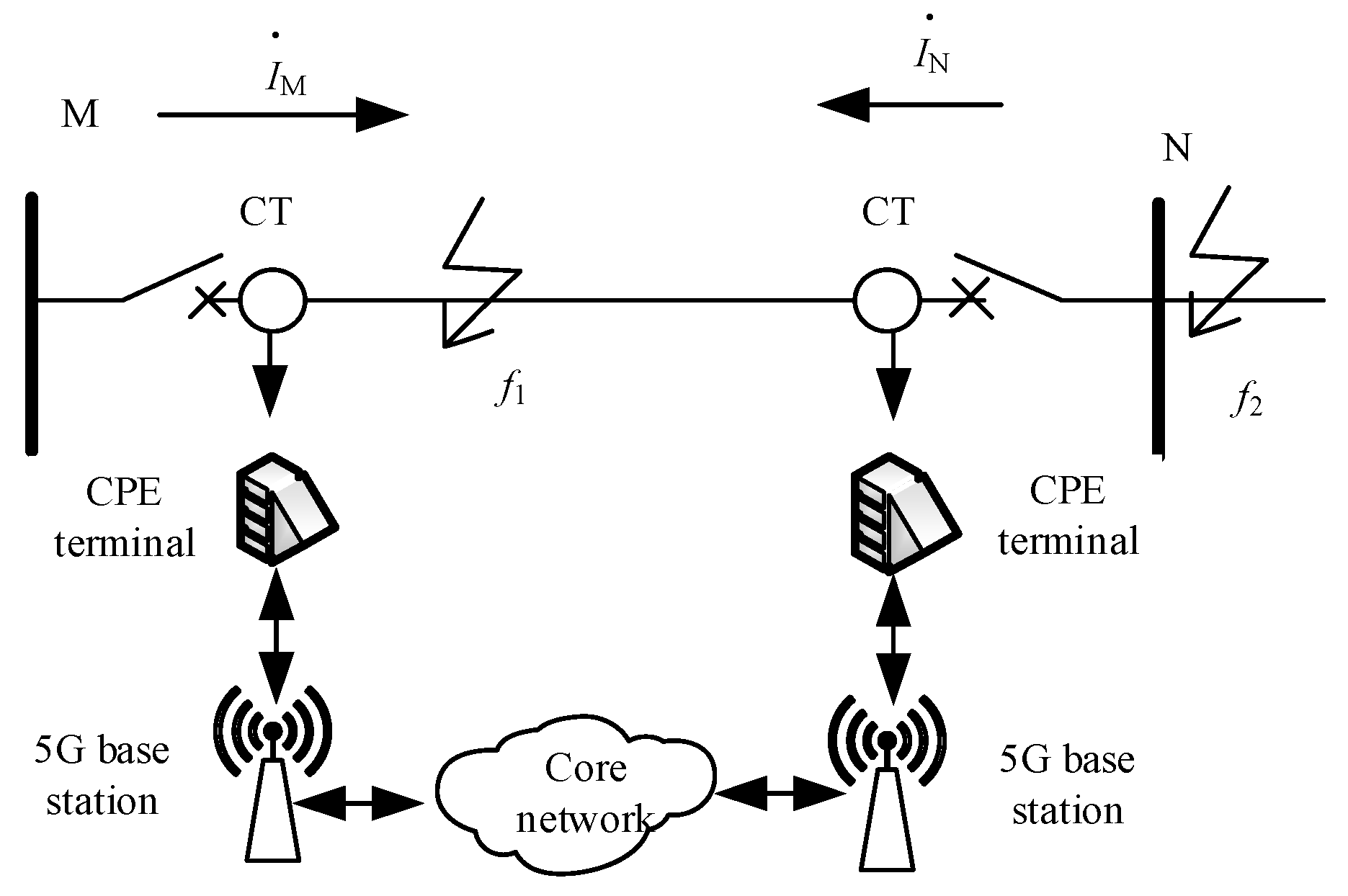
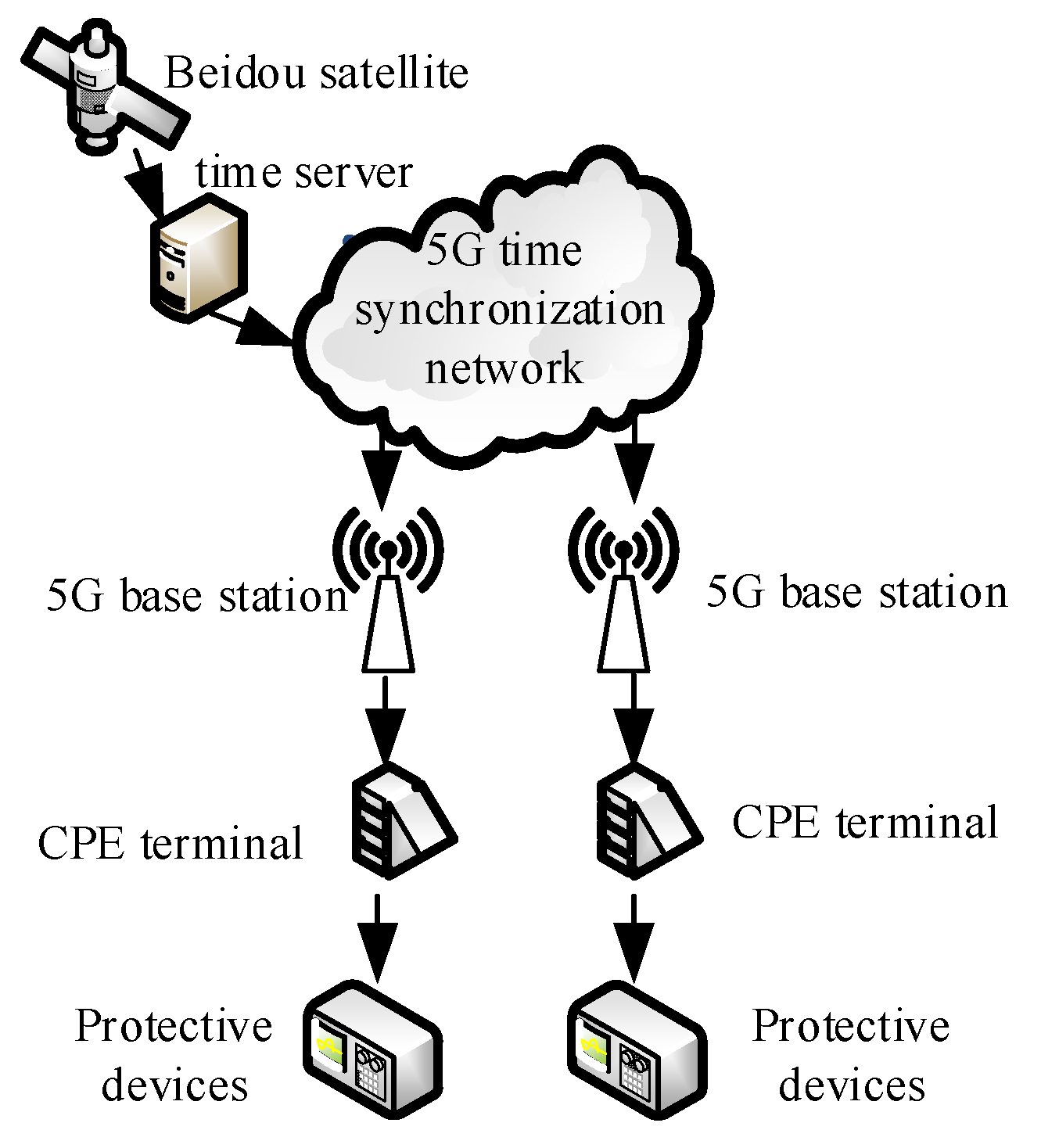

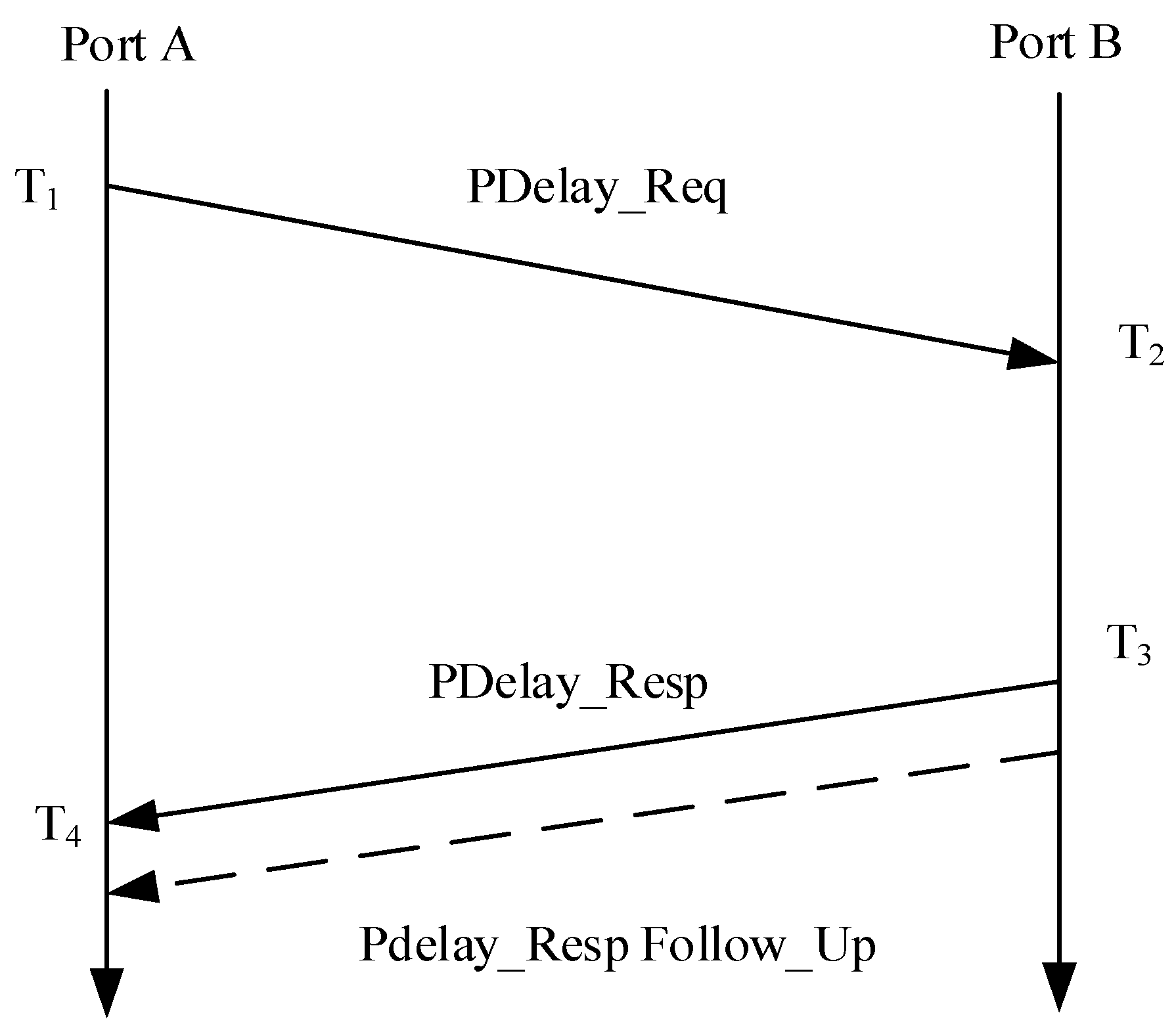
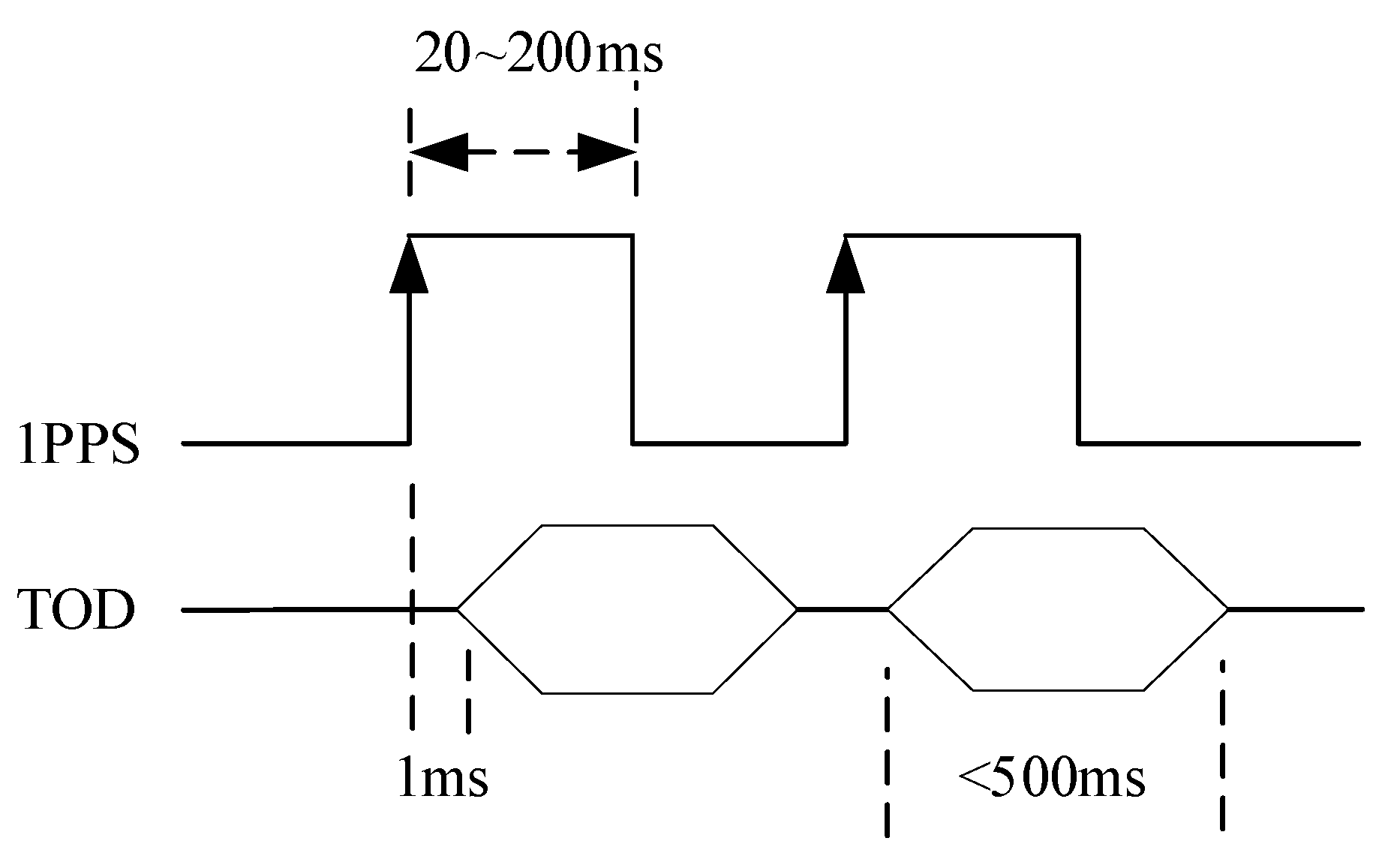
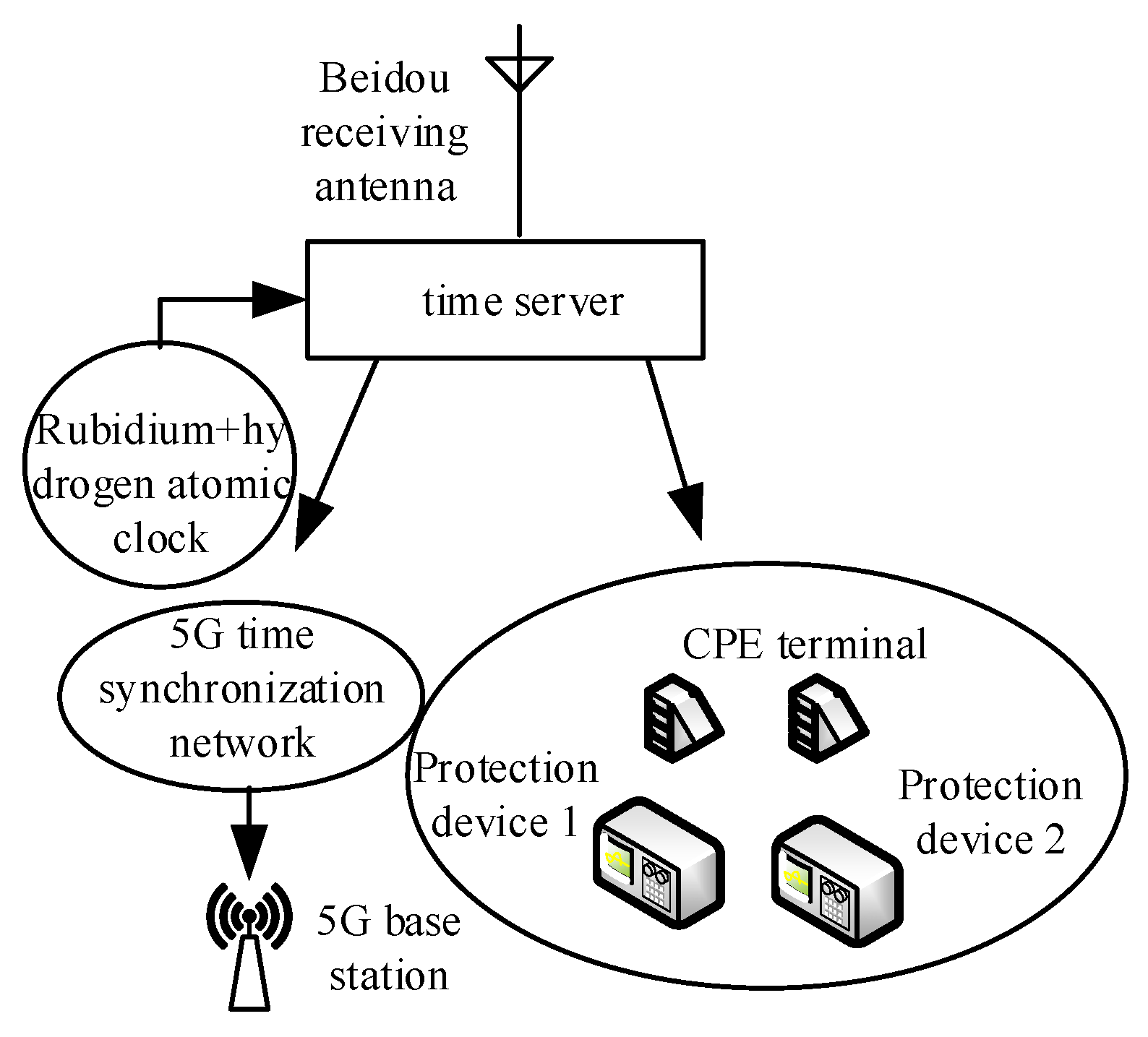
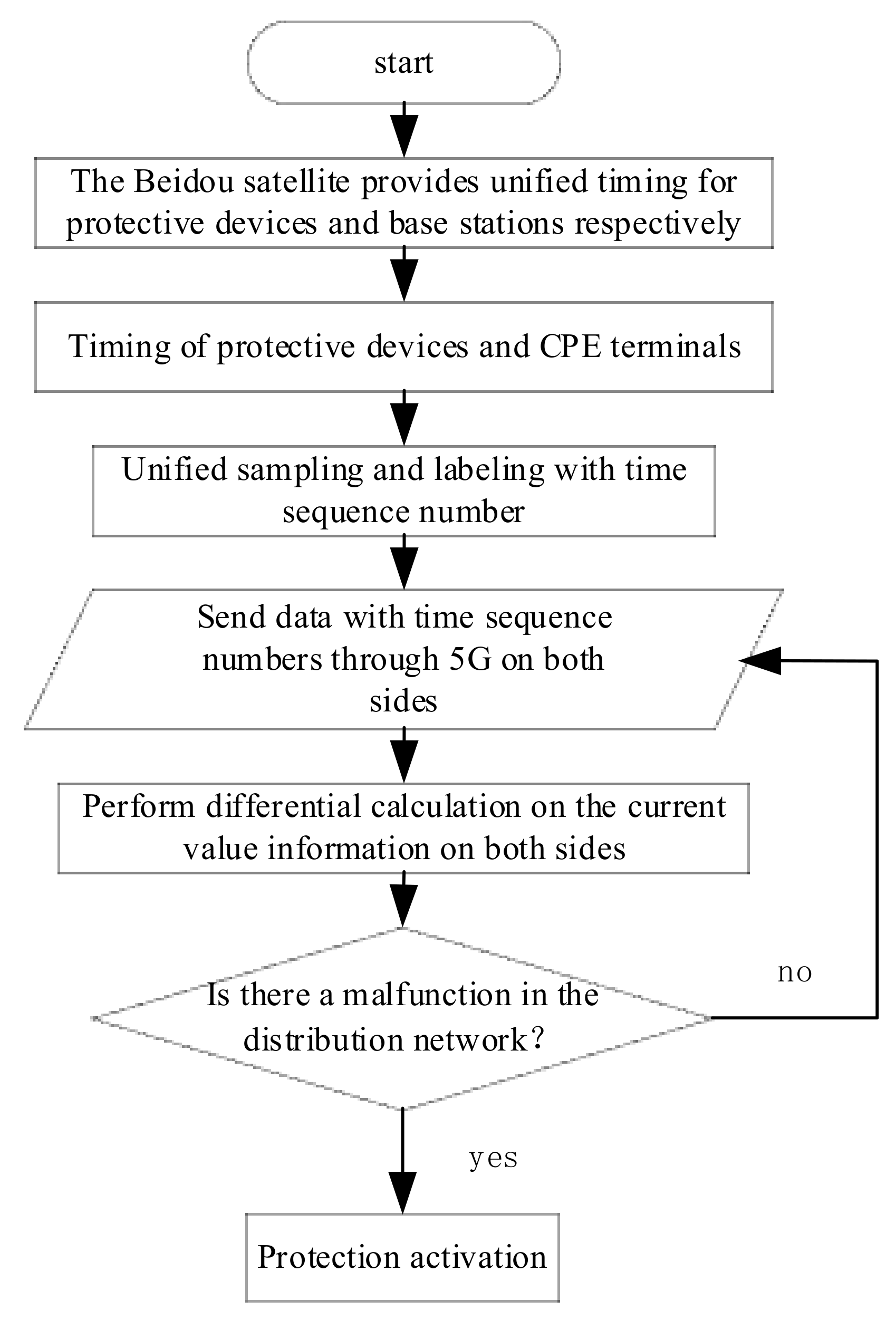

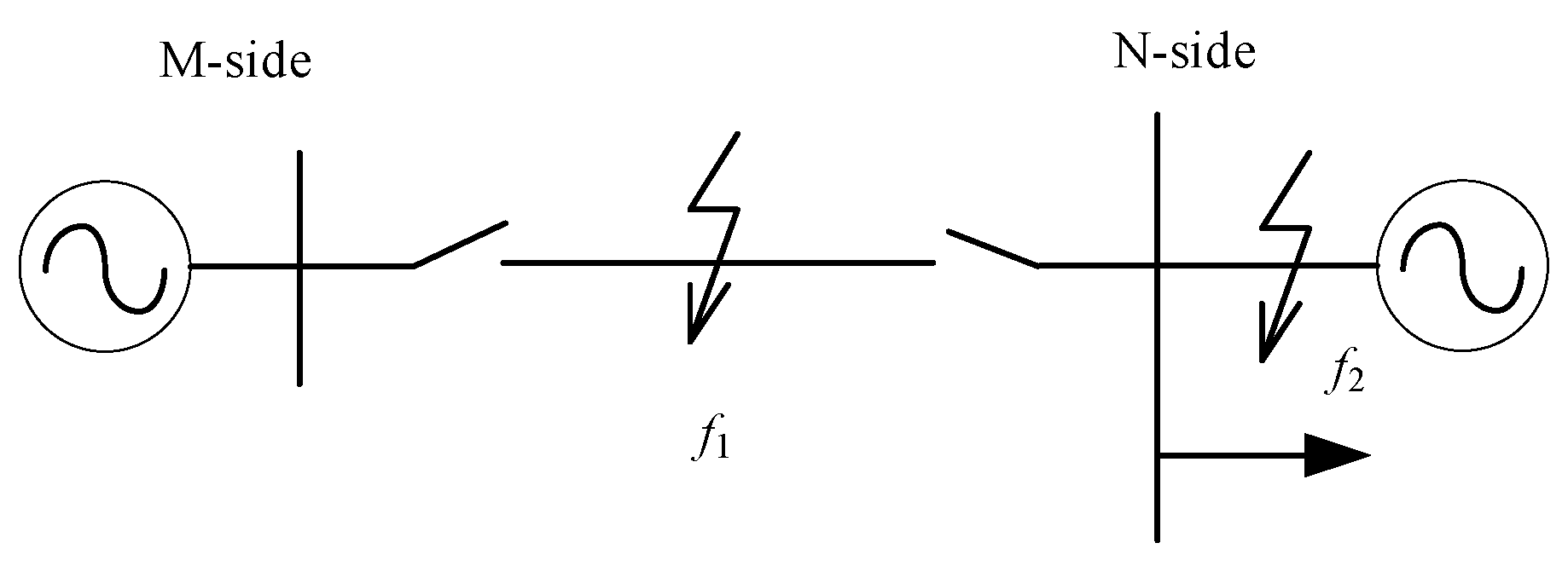
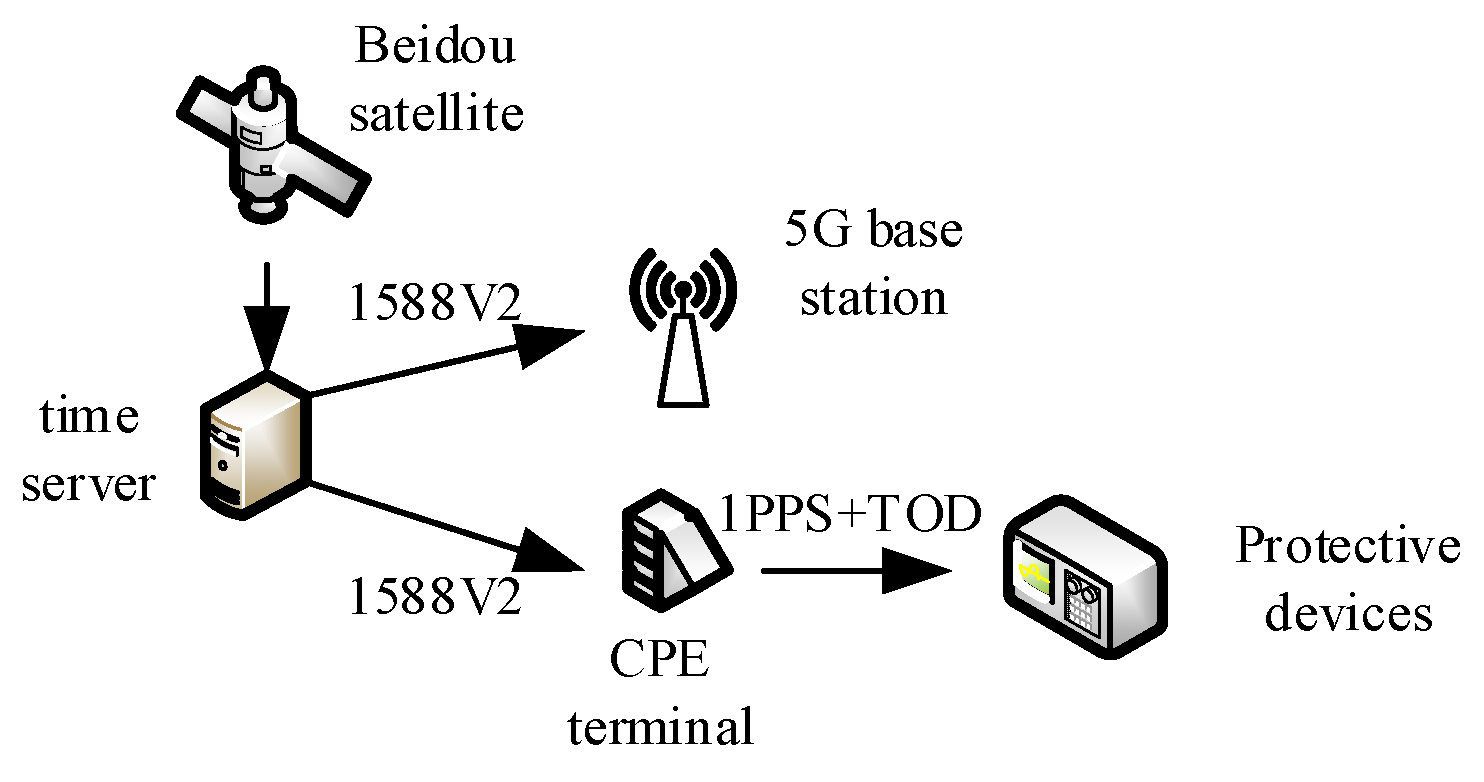
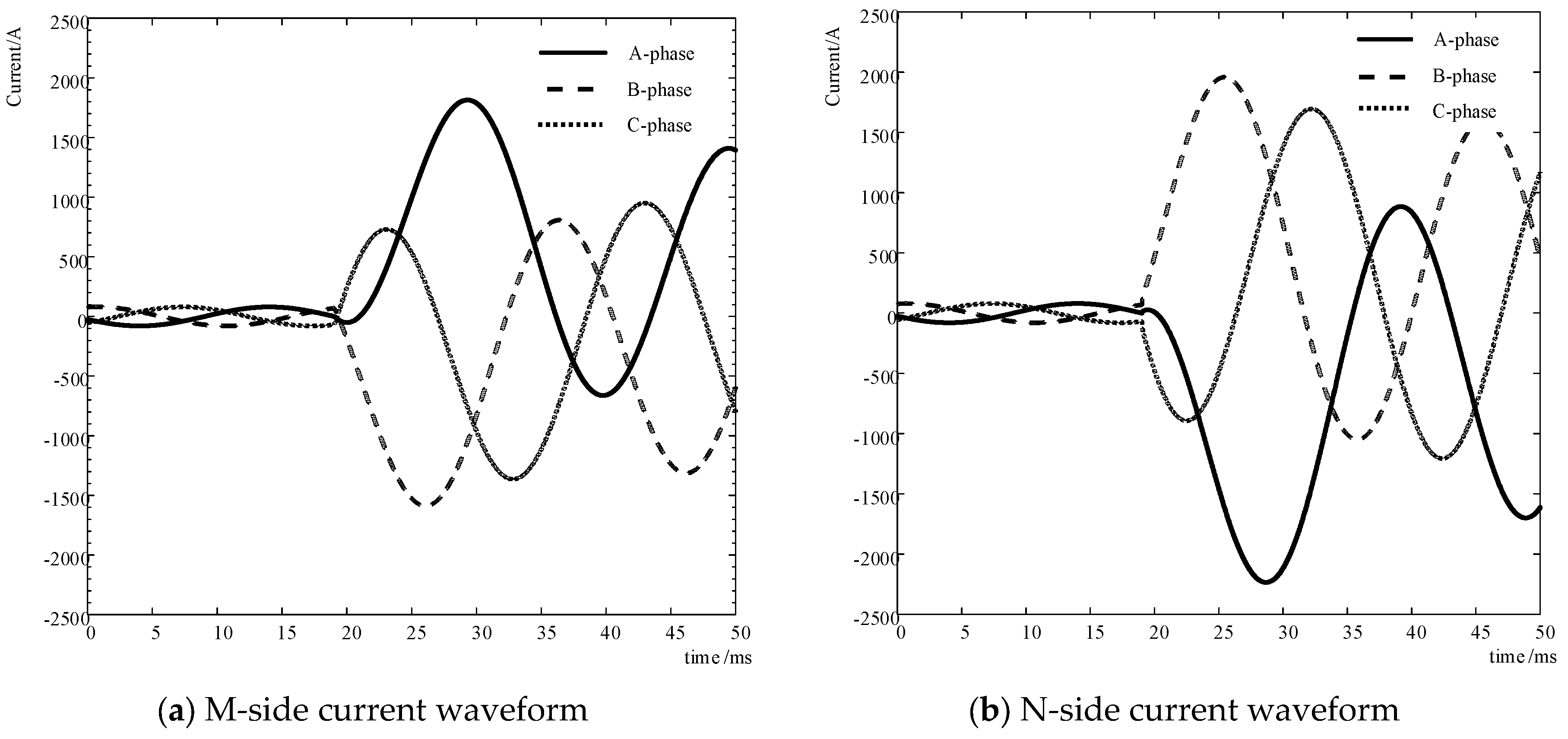
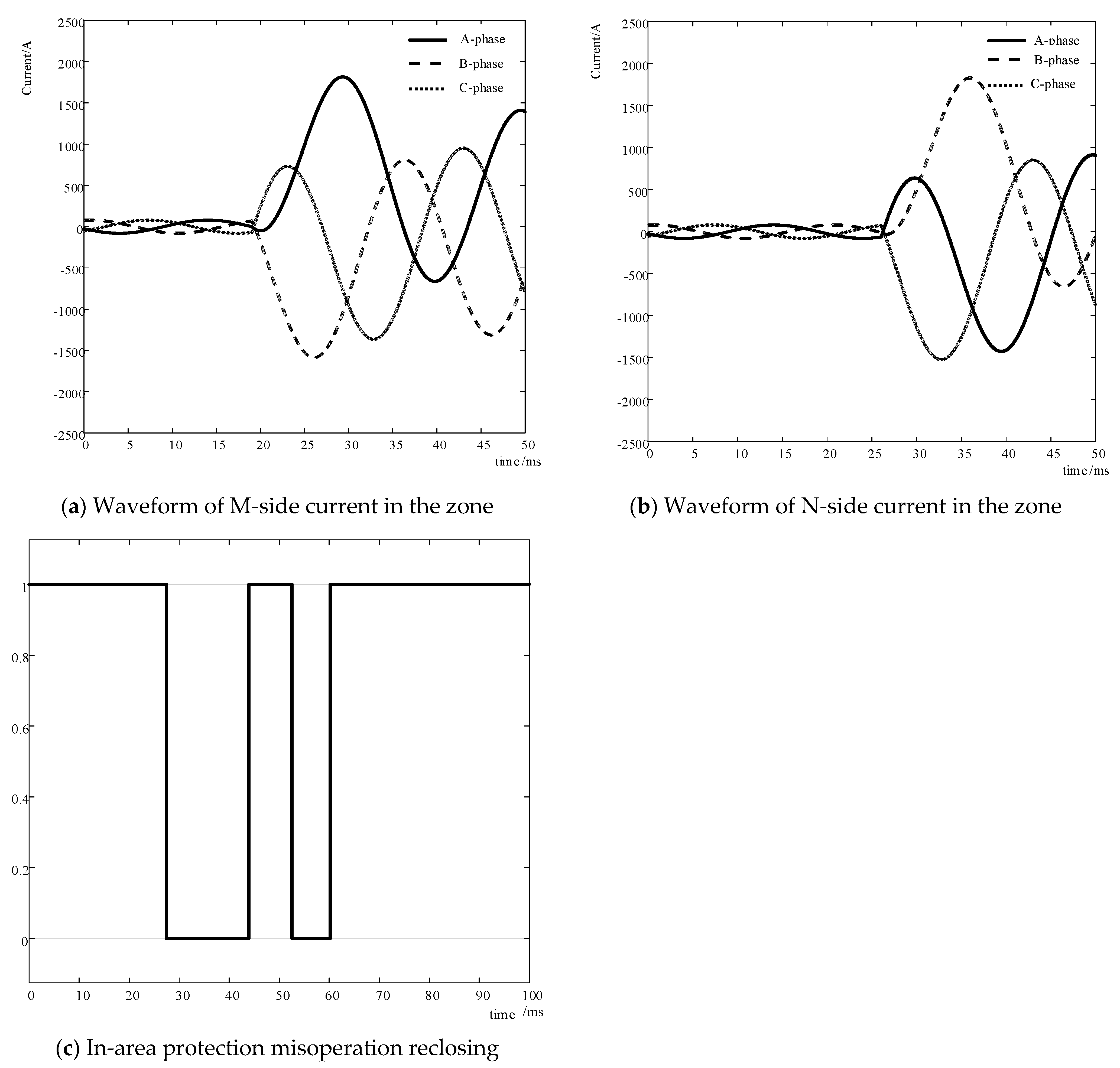
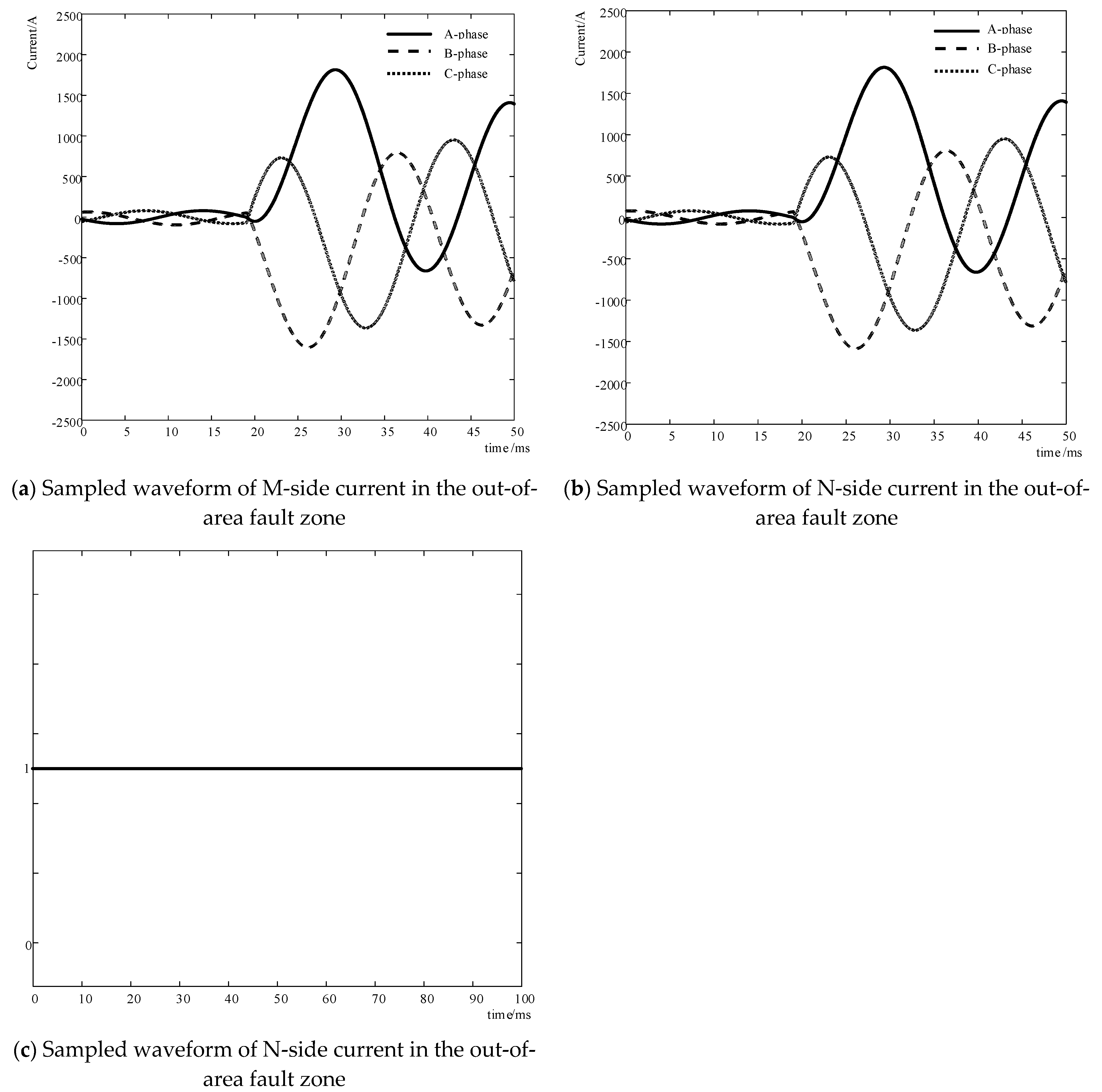
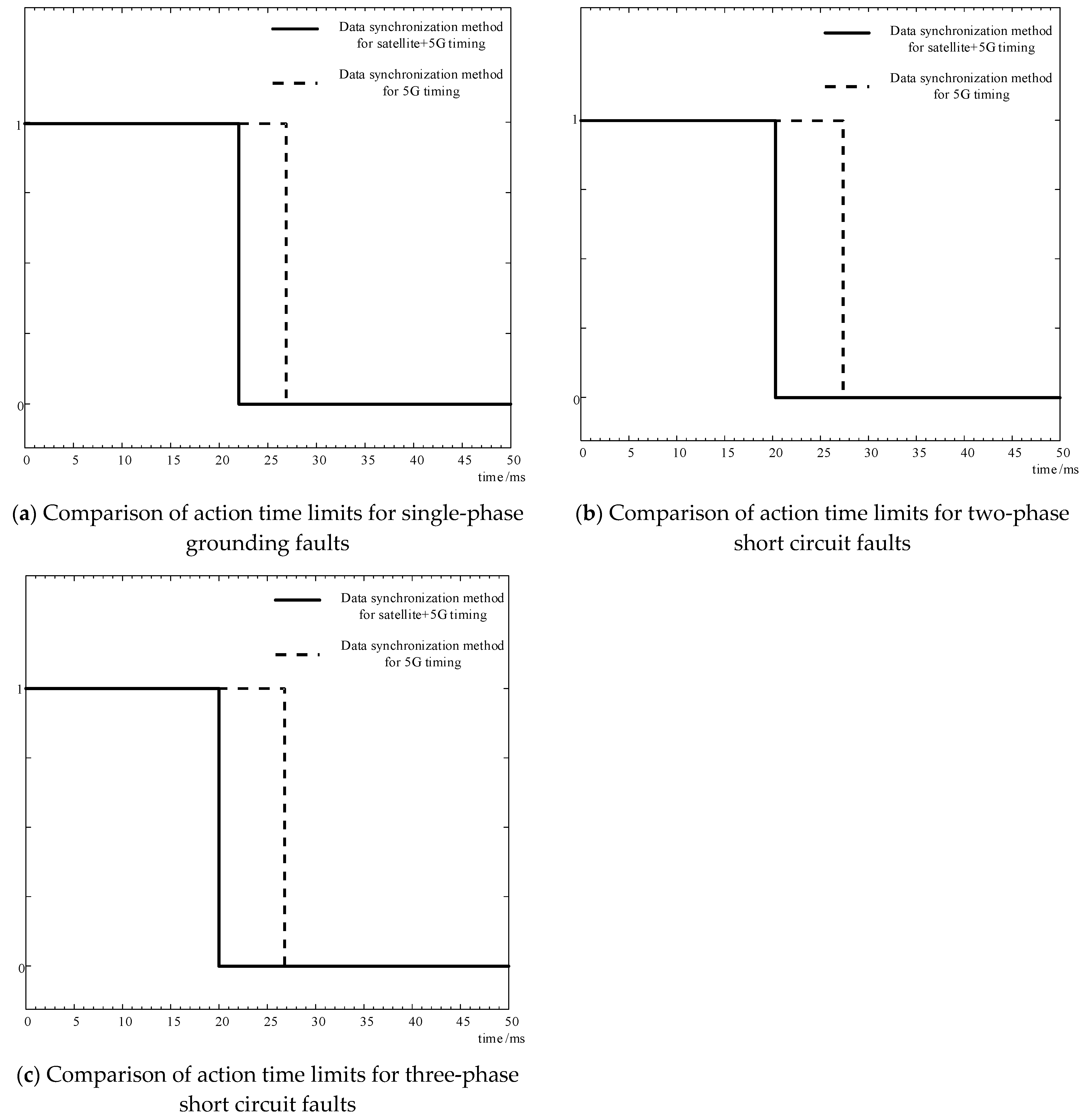
| Single Phase Ground Fault | Two-Phase Short-Circuit Fault | Three-Phase Short-Circuit Fault | ||
|---|---|---|---|---|
| Data synchronization method for 5G timing | Action time limit/ms | 26.894 | 27.348 | 26.742 |
| Improved data synchronization method | 22.045 | 20.379 | 20.076 | |
| Comparison time difference between the two/ms | 4.849 | 6.969 | 6.666 | |
Disclaimer/Publisher’s Note: The statements, opinions and data contained in all publications are solely those of the individual author(s) and contributor(s) and not of MDPI and/or the editor(s). MDPI and/or the editor(s) disclaim responsibility for any injury to people or property resulting from any ideas, methods, instructions or products referred to in the content. |
© 2024 by the authors. Licensee MDPI, Basel, Switzerland. This article is an open access article distributed under the terms and conditions of the Creative Commons Attribution (CC BY) license (https://creativecommons.org/licenses/by/4.0/).
Share and Cite
Fan, H.; Wang, W.; Cheng, J.; Yuan, Z.; Li, X.; Yan, S.; Zhu, J. Research on Improvement of Data Synchronization Method for Distribution Network Differential Protection Based on 5G. Energies 2024, 17, 778. https://doi.org/10.3390/en17040778
Fan H, Wang W, Cheng J, Yuan Z, Li X, Yan S, Zhu J. Research on Improvement of Data Synchronization Method for Distribution Network Differential Protection Based on 5G. Energies. 2024; 17(4):778. https://doi.org/10.3390/en17040778
Chicago/Turabian StyleFan, Haiqiang, Weiqing Wang, Jing Cheng, Zhi Yuan, Xiaozhu Li, Sizhe Yan, and Jinlong Zhu. 2024. "Research on Improvement of Data Synchronization Method for Distribution Network Differential Protection Based on 5G" Energies 17, no. 4: 778. https://doi.org/10.3390/en17040778
APA StyleFan, H., Wang, W., Cheng, J., Yuan, Z., Li, X., Yan, S., & Zhu, J. (2024). Research on Improvement of Data Synchronization Method for Distribution Network Differential Protection Based on 5G. Energies, 17(4), 778. https://doi.org/10.3390/en17040778





